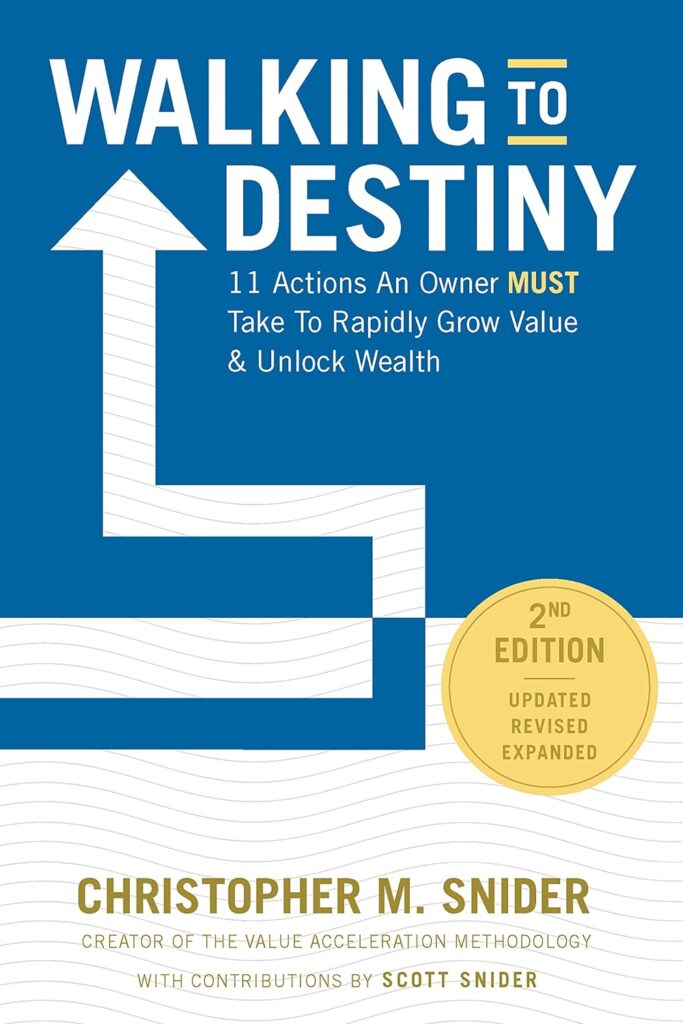Walking to Destiny by Christopher Snider is written for business owners and the advisors that help them. It teaches the Value Acceleration methodology at the core of the Exit Planning Institute’s CEPA certification program and provides a common approach and language for financial advisors, accountants, lawyers, and consultants to all work in concert in helping owners improve the performance of their business, build intangible capital, and prepare the business and themselves for their exit, whenever that might happen.
Although the book is about “exit planning”, having the best possible exit from your business (financially and personally) requires years of planning. The Value Acceleration methodology is designed to assess an owner’s present readiness to exit and then iteratively and systematically take actions that increase the near term performance of their business while increasing its value when they do exit, and as importantly, preparing the owner for life after the exit. Optimally, a business owner would read Walking to Destiny years before they plan to exit.
For the past couple of years I’ve been helping a client prepare to successfully exit his business. One of the client’s other advisors recommended that I pursue CEPA certification. Once I understood that “exit planning” was really what I would call “strategic planning with the end in mind”, it made perfect sense and I am now pursuing my CEPA.
Unlike large corporations or venture backed startups, most small businesses are privately owned by the people who run them. There are 32 million privately held businesses in the U.S. with a total of $37 trillion in annual sales. At some point in time, these owners plan to exit their businesses (and, with our aging population, 63% plan on exiting in the next 10 years). Most of them have been so busy running the business, they haven’t taken the time to plan for that exit and so, only 20-30% of them that try to sell their businesses succeed. Even those that decide to keep the business in the family are unprepared, with only 30% having success in the 2nd generation (and far fewer beyond). The owners also typically haven’t done much planning for their own lives beyond retirement, with three out of four profoundly regretting their decision 12 months after selling their business.
In addition to being busy, although business owners have multiple advisors (their CPA, their lawyer, their personal financial advisor), each of those advisors is focused on just one aspect of the puzzle, sometimes giving conflicting advice, and often overlooking critical gaps. I’m thankful that my client brought me in as a consultant to focus on the overall picture and help him identify and fill some of those gaps, but even so, working with the business owner’s other advisors hasn’t been tightly coordinated. The Exit Planning Institute provides the training and certification to get all of these people working together to prepare the business and the owner for that eventual future date when the owner leaves the business.
I love tools and methodologies, so at first I was frustrated that the author didn’t jump right in to teaching me this new approach. In hindsight, I understand the wisdom of his approach. Part One of the book makes the case for advanced planning for your eventual exit from your business. Part Two of the book covers the five fundamental principles that an owner needs to understand for the Value Acceleration methodology to make sense. Part Three finally gets to the details of the methodology itself. Part Four provides practical guidance for owners and advisors on how to most effectively implement the Value Acceleration methodology.
Bottom line, Walking to Destiny is a great introduction for business owners of the work they need to do to prepare their business and themselves to transition the business to new ownership. I strongly recommend this book for business owners and those that advise them, whether or not they plan on using the methodology.

